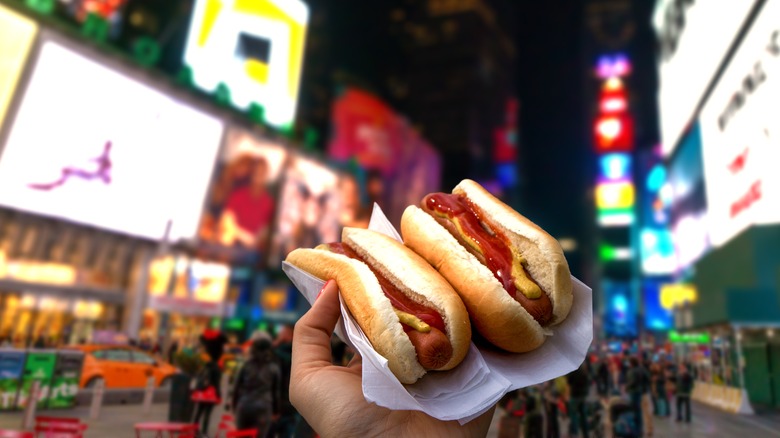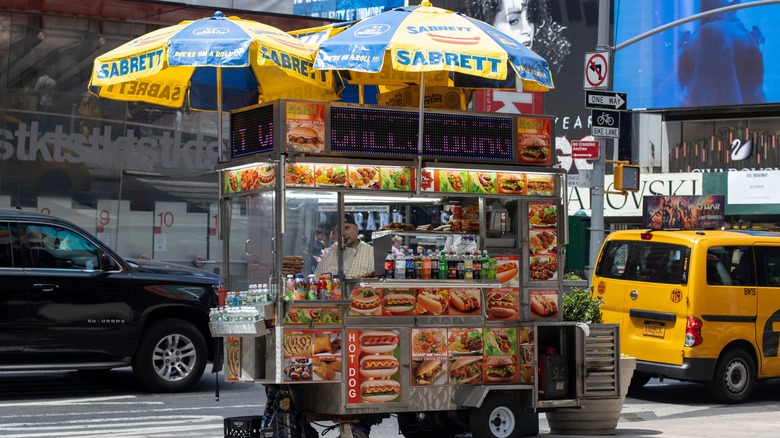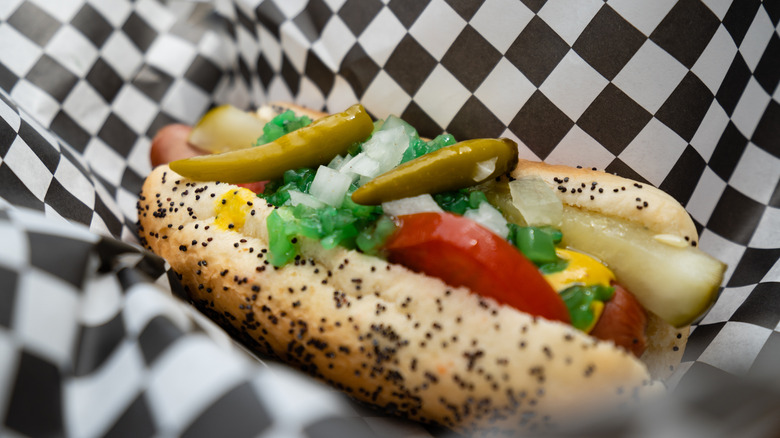What Makes A New York Style-Hot Dog So Legendary?
Even if you're not from New York City, you've probably at least heard of its famous food carts. From pretzels to hot dogs, the simple fare takes on a very specific air that makes it special nonetheless. But what is it about New York-style hot dogs that makes them so legendary? It could be the toppings, the buns, the "dirty water" that they're boiled in, or — more likely — all of those factors combined.
If you wrinkled up your nose at the mention of dirty water you'll want to hold on just a minute — it isn't nearly as bad as it sounds. While the liquid certainly looks murky, its appearance is due to an array of seasonings and flavorings. The water just happens to be loaded up with a delicious combination of spices like cumin, nutmeg, and red pepper that no doubt give it a very interesting color. Vinegar is splashed in, as is tomato sauce, ketchup, and even sauerkraut at select stands. And, of course, onions have a place in the water, too. Then there's all the flavor left behind by the preceding batch of hot dogs. Other variations may exist, but those are the basics. The result is a hot dog that tastes unlike anything you'll get anywhere else. Regular boiled hot dogs, and even grilled ones, pale in comparison to the dirty water dog.
New York-style toppings
New York's iconic hot dogs also come with their own special toppings, with one in particular standing out: onion sauce. The thick, chunky condiment — popularized by hot dog purveyor Sabrett — isn't often found at hot dog stands outside the city, but it's a staple that New Yorkers expect to find at pretty much every pushcart and stand. Consisting of cooked onions, tomato paste, and plenty of seasonings, the sauce is a serious upgrade from the usual ketchup and onion toppings available elsewhere.
Other common toppings generally ordered at New York hot dog stands include sauerkraut (and to a lesser extent, pickle relish). Just don't expect to get away with using regular yellow mustard — the spicy brown deli-style stuff is standard. Nor should you expect a toasted bun. Steamed hot dog buns are how it's done, with the soft white bread meant to soak up all those tasty juices from the dirty water.
A mainstay of the city's culture — New Yorkers and famous visitors alike flock to the hot dog stands lining its busy streets. Sabrett's blue and yellow umbrellas represent New York's quintessential hot dog experience. Another popular New York hot dog combination pairs the frankfurters with tropical fruit juices — as sold by a number of brands with papaya in the name. There is Papaya King, Gray's Papaya, Papaya Dog, and more, all hawking the unique pairing, which relies on the frothy sweet drinks to cut through the hot dog's salty meatiness.
How New York-style hot dogs compare to other regional styles
While "dirty water," sauerkraut, deli-style mustard, and sweet onion sauce are all hallmarks of New York-style hot dogs, other cities have their own claims to fame when it comes to the street food. In Los Angeles, you'll get a hot dog wrapped in bacon and topped with grilled goodies like onions and peppers. Expect a seriously hearty dog in Atlanta, complete with chili and cole slaw. Detroit's hot dogs also make use of chili: The city's famous "coney dogs" — which include onion and shredded cheese — are a favorite among hot dog eaters nationwide.
Chicago-style hot dogs might be some of the most well-known outside of NYC. They're often made from Vienna Beef, a brand that gets its unique taste from the addition of pastrami and corned beef, a special mix of spices, and a signature casing. Instead of the regular white bun, this savory dog is served in a poppyseed bun and then topped with a "garden" of condiments that include just about everything (yellow mustard, sport peppers, bright green relish) — except for ketchup. On that last part, many hot dog-loving New Yorkers seem to agree.


